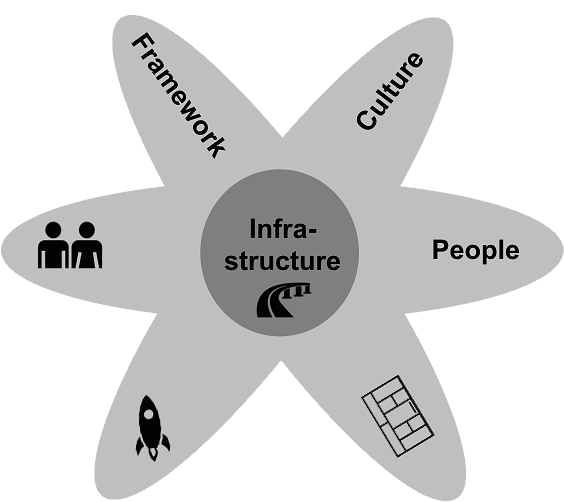Building digital ecosystems in a large enterprise
Digital transformation is not only about technology, but rather about reshaping the organisation to enable and foster innovation.
The Global Digital Factory (GDF) is enabling Allianz companies to digitize and strengthen customer ties. GDF has been working with Futurice Digital Transformation at an early stage to help set up and evolve the Digital Factory structures.
Building autonomous digital ecosystems within the enterprise can accelerate this digital transformation by overcoming the factory mindset.
There is no detailed roadmap for setting up and maintaining digital ecosystems, as these are per definition highly adaptive systems that are strongly influenced by the context of the enterprise and its legacies. However, there are some basic principles for initiating dynamic ecosystems that can thrive in adopting (and creating) new ways of working and innovating and thus contribute to the enterprise's transformation:
 Initiating Digital Ecosystems in Large Enterprises
Initiating Digital Ecosystems in Large Enterprises
People
One of the principles of lean agile change is to "use volunteering" (e. g. as stated in Large Scale Scrum). Enabling motivated employees to lead the change can be crucial for its success. However, experiences these people have gathered within the enterprise are often an obstacle for their own imagination and can draw them back to secure, convenient enterprise patterns. Pairing volunteers with new talents who have mainly gathered their experiences on the other side of the economy (startups, digital companies, creative agencies) has proved to be a good way to push for open and collaborative digital ecosystems.
Culture
Bringing people from different silos, different management levels or different economies together can be challenging. But the fact that these people cannot rely on common patterns of communication and collaboration (as is the case in an enterprise silo for example) is actually a huge opportunity. By defining new rules of engagement, communication and collaboration, interdisciplinary teams can create a new culture that will be a better fit to the goals and promises of the digital ecosystem than the "old" enterprise culture. Starting with a definition of behaviour or "behaviour patterns" rather than abstract values, is a good and rather lean way of forming new cultures (learn more here). A simple, but effective approach to this is co-creating a "community protocol" that lists a few (mainly behaviour) principles to which all stakeholders in the ecosystems shall commit.
Framework
An ecosystem community should be able to create its own framework defining vision, goals, KPIs and work structures. However, providing an initial set of innovation fostering frameworks and tools (lean startup, design thinking, agile development, lean service creation) can help kickstart the community into a working mode that can be evolved or pivoted by the stakeholders.
Infrastructure
In their 2015 annual report, Rocket Internet introduced their approach of building an maintaining an infrastructure that services autonomous digital ecosystems (click here for the full report). This infrastructure platform is designed to "build companies in less than 100 days". There are two main differences between this ecosystem inspired approach and the classic "centralized IT" philosophy of traditional enterprises:
- Build Services, Not Solutions: while SkyRocket provides various technology services to "its customers", it keeps itself at distance from offering solutions, as these are usually tied to the businesses of the companies yet to be built (i. e. to the unknown). Major data and technology services are provided by the core, while solution and custom services are created in the belt.
- Governance by Benefit, Not by Control: the platform's aim is to provide the critical level of added value that would make new evolving digital ecosystems use it's services rather than rebuilding them. Exchanging service for transparency (the ecosystem sharing its data with the core) is the new governance model that fosters business innovation in the belt and pushes for the same level on the core.
Conclusion
Autonomous, innovative digital ecosystems are important for the transformation of large enterprises. Pairing new talents with motivated employees, defining behaviour principles of a new culture and providing good technology services from the core while creating business solutions and custom services in the belt is a good way to initiate these ecosystems.
This article is part of a series designed to help enterprises become more lean. We’re partnering with Lean Enterprise co-author, Barry O’Reilly, to host executive roundtable sessions in London and Berlin, as well as an event in Helsinki, ‘Lean Rocks’, all during February and March. Futurice and Barry will be offering bespoke training and workshops with clients in Helsinki and Tampere, if you’re interested in learning more about this please contact Timo Hyväoja.
 Raid NaimHead of Digital Transformation
Raid NaimHead of Digital Transformation- Telina ReilGlobal Digital Factory Manager, Allianz SE


